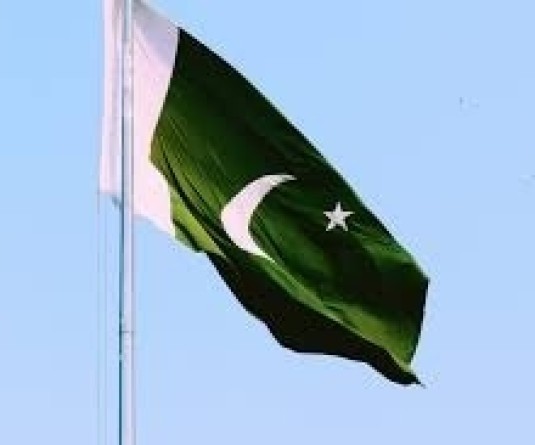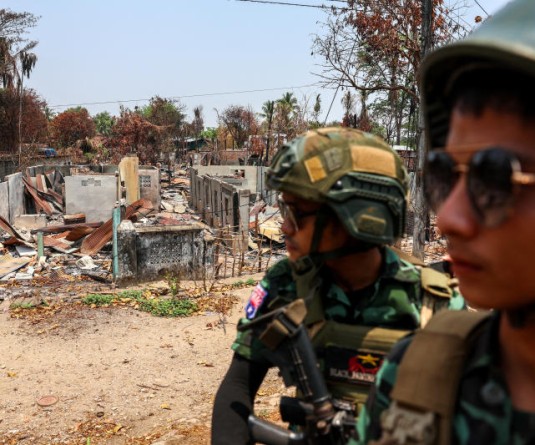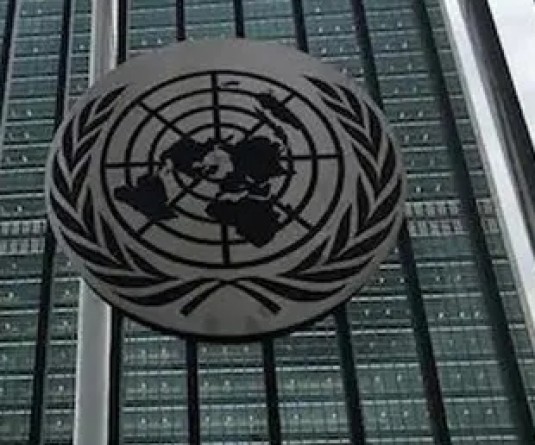
Rescue workers climb onto the collapsed Pyne Gould Guinness Building in central Christchurch, New Zealand, Tuesday, Feb. 22 2011. A powerful earthquake collapsed buildings at the height of a busy workday killing at least 65 people and trapping dozens in one of the country's worst natural disasters. (AP Photo/New Zealand Herald, Mark Mitchell) NEW ZEALAND OUT, AUSTRALIA OUT
CHRISTCHURCH, February 22 (AP): A powerful earthquake struck one of New Zealand's biggest cities Tuesday at the height of a busy workday, toppling tall buildings and churches, crushing buses and killing at least 65 people in one of the country's worst natural disasters.
It was the second major quake to hit Christchurch, a city of 350,000, in five months, though Tuesday's 6.3-magnitude temblor caused far more destruction than a stronger September quake that struck before dawn on a weekend. More than 100 people, including as many as a dozen visiting Japanese students, were thought to be trapped in the rubble as darkness - and drizzling rain - fell Tuesday night.
"It is just a scene of utter devastation," Prime Minister John Key said after rushing to the city within hours of the quake. He said the death toll was 65, and may rise. "We may well be witnessing New Zealand's darkest day."
The spire of the city's well-known stone cathedral toppled into a central square, while multistory buildings collapsed in on themselves and streets were strewn with bricks and shattered concrete.
Sidewalks and roads were cracked and split, while thousands of dazed, screaming and crying residents wandered through the streets as sirens and car alarms blared. Ambulance services were quickly overwhelmed, and groups of people helped victims clutching bleedings wounds, and others were carried to private vehicles in makeshift stretchers fashioned from rugs or bits of debris.
Nathanael Boehm, a web designer, said he was standing near a tram track when the quake struck just before 1 p.m., sending the eaves of buildings cascading onto the street below.
Christchurch Mayor Bob Parker declared a state of emergency and ordered people to evacuate the city center. He said it was impossible to say how many people were trapped in the rubble, but that it was estimated to be more than 100. "The government is willing to throw everything it can in the rescue effort," Deputy Prime Minister Bill English said.
Troops were deployed to help people get out and to throw up a security cordon around the stricken area, and residents throughout the city were urged to stay home or with neighbors and conserve water and food.
The airport was closed, and Christchurch Hospital was briefly evacuated before reopening. Power and telephone lines were knocked out, and pipes burst, flooding the streets with water. Some cars parked on the street were buried under rubble.
Police said reports of fatalities included people in two buses that had been crushed by falling buildings. During hours of chaos in the city, people dug through rubble with their hands to free people trapped. Firefighters climbed extension ladders to pluck people stranded on roofs to safety. A crane lifted a team of rescuers on a platform to one group of survivors in a high-rise. Plumes of gray smoke drifted into the air at several points around the city from fires burning in the rubble.
Parker said rescue teams including sniffer dogs were fanning out across the city and would work through the night.
Officials had established relief centers in schools and community halls, where food was being served to thousands of sheltering people and donated blankets were being handed out. In at least one park in the city, people - many of them tourists who had abandoned their hotels - huddled in hastily pitched tents and under plastic sheeting. The Red Cross was working to secure accommodation for them.
Key, who held an emergency Cabinet meeting then rushed to the stricken city to observe the scene, said eight or nine buildings had collapsed, and others were badly damaged. Some of those stuck were thought to be visiting Japanese students who called their parents back home to say they were in a collapsed building, a Japanese official said.
Two students from the Toyama College of Foreign Languages remained trapped, while 11 were unaccounted for and could still be in the building, said the official from Toyama Prefecture, who declined to provide his name because he was not authorized to give public statements. Eight students and two teachers from the school had been freed from the wreckage, he said. Others were also able to call out using their mobile phones, reaching family, officials, and media.
"I rang my kids to say goodbye," said Ann Voss, interviewed by TV3 from underneath her desk where she was trapped in a collapsed office building.
Gary Moore said he and 19 other colleagues were trapped in their twelfth floor office after the stairwell collapsed in the quake. "We watched the cathedral collapse out our window while we were holding onto the walls," Moore said.
The multistory Pyne Gould Guinness Building, housing more than 200 workers, collapsed and an unknown number of people were trapped inside.
The U.S. Geological Survey said the temblor was centered 3 miles from the city at a depth of 2.5 miles. Two large aftershocks - one magnitude 5.6 and another 5.5 - hit the city within two hours.
It was the second major quake to hit Christchurch, a city of 350,000, in five months, though Tuesday's 6.3-magnitude temblor caused far more destruction than a stronger September quake that struck before dawn on a weekend. More than 100 people, including as many as a dozen visiting Japanese students, were thought to be trapped in the rubble as darkness - and drizzling rain - fell Tuesday night.
"It is just a scene of utter devastation," Prime Minister John Key said after rushing to the city within hours of the quake. He said the death toll was 65, and may rise. "We may well be witnessing New Zealand's darkest day."
The spire of the city's well-known stone cathedral toppled into a central square, while multistory buildings collapsed in on themselves and streets were strewn with bricks and shattered concrete.
Sidewalks and roads were cracked and split, while thousands of dazed, screaming and crying residents wandered through the streets as sirens and car alarms blared. Ambulance services were quickly overwhelmed, and groups of people helped victims clutching bleedings wounds, and others were carried to private vehicles in makeshift stretchers fashioned from rugs or bits of debris.
Nathanael Boehm, a web designer, said he was standing near a tram track when the quake struck just before 1 p.m., sending the eaves of buildings cascading onto the street below.
Christchurch Mayor Bob Parker declared a state of emergency and ordered people to evacuate the city center. He said it was impossible to say how many people were trapped in the rubble, but that it was estimated to be more than 100. "The government is willing to throw everything it can in the rescue effort," Deputy Prime Minister Bill English said.
Troops were deployed to help people get out and to throw up a security cordon around the stricken area, and residents throughout the city were urged to stay home or with neighbors and conserve water and food.
The airport was closed, and Christchurch Hospital was briefly evacuated before reopening. Power and telephone lines were knocked out, and pipes burst, flooding the streets with water. Some cars parked on the street were buried under rubble.
Police said reports of fatalities included people in two buses that had been crushed by falling buildings. During hours of chaos in the city, people dug through rubble with their hands to free people trapped. Firefighters climbed extension ladders to pluck people stranded on roofs to safety. A crane lifted a team of rescuers on a platform to one group of survivors in a high-rise. Plumes of gray smoke drifted into the air at several points around the city from fires burning in the rubble.
Parker said rescue teams including sniffer dogs were fanning out across the city and would work through the night.
Officials had established relief centers in schools and community halls, where food was being served to thousands of sheltering people and donated blankets were being handed out. In at least one park in the city, people - many of them tourists who had abandoned their hotels - huddled in hastily pitched tents and under plastic sheeting. The Red Cross was working to secure accommodation for them.
Key, who held an emergency Cabinet meeting then rushed to the stricken city to observe the scene, said eight or nine buildings had collapsed, and others were badly damaged. Some of those stuck were thought to be visiting Japanese students who called their parents back home to say they were in a collapsed building, a Japanese official said.
Two students from the Toyama College of Foreign Languages remained trapped, while 11 were unaccounted for and could still be in the building, said the official from Toyama Prefecture, who declined to provide his name because he was not authorized to give public statements. Eight students and two teachers from the school had been freed from the wreckage, he said. Others were also able to call out using their mobile phones, reaching family, officials, and media.
"I rang my kids to say goodbye," said Ann Voss, interviewed by TV3 from underneath her desk where she was trapped in a collapsed office building.
Gary Moore said he and 19 other colleagues were trapped in their twelfth floor office after the stairwell collapsed in the quake. "We watched the cathedral collapse out our window while we were holding onto the walls," Moore said.
The multistory Pyne Gould Guinness Building, housing more than 200 workers, collapsed and an unknown number of people were trapped inside.
The U.S. Geological Survey said the temblor was centered 3 miles from the city at a depth of 2.5 miles. Two large aftershocks - one magnitude 5.6 and another 5.5 - hit the city within two hours.





